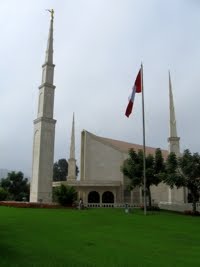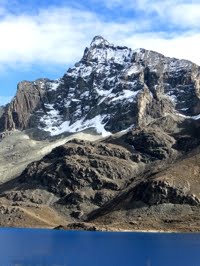This is a picture of the Tarma valley. It shows the dirt roads we took up the mountain to the Yanamarca ruins:

The Palcamayo valley as viewed 3000 feet above on the cliffs of Yanamarca:

Beverly and Scott pose on the cliff by 1000-year-old, pre-Inca ruins of Yanamarca:

We had the great blessing of seeing many of our dearest Peruvian friends. Our closest friends were the Durmand family shown here--Karola, Alex, Durman, and Cami:

Other dear friends bid us farewell at our Tarma hotel--Mayra Quinto, José Quinto, Sharon (granddaughter of José), Beverly, Martha (wife of José), Scott, Caroli Leyva, Sister Leyva (no relation to our former mission president), Sister Chuco, and Ángel Chuco:

After visiting our former missionary area of Tarma, we traveled to Tarapoto, in the high Peruvian jungle on the eastern slopes of the Andes. There we worked with the Rotary International Club of Tarapoto to inspect and initiate a water-conservation and reforestation project:

From Tarapoto, we flew to Iquitos in the low Peruvian jungle of the Amazon basin. This is a hut on the banks of the mighty Amazon River:

We stayed in a rustic lodge in the jungle:

We inspected three fish-farm projects sponsored by Rotary International and the Hope Alliance of Salt Lake City. This fish farm was located just outside the village of Yanayaco in the dense jungle:

Two other Hope Alliance fish farms were located near the jungle village of Las Palmas. This is a member of the village:

Four Las Palmas boys, ages 10-13, walked with Scott into the jungle to inspect the fish farms :

Hope Alliance also sponsors micro-credit loans in Iquitos. This woman received a loan to begin her sewing shop, where she sews shirts, dresses, and sports clothing:
+with+clothes+she+has+sown.jpg)
Boathouses on a river that passes through Iquitos:

A houseboat in Belén, a suburb of Iquitos:

Houses on stilts along the river in Belén:

We loved our return to the Peru Lima East Mission and our visit to a new part of Peru, the jungle cities of Tarapoto and Iquitos. It was a magnificent trip.













